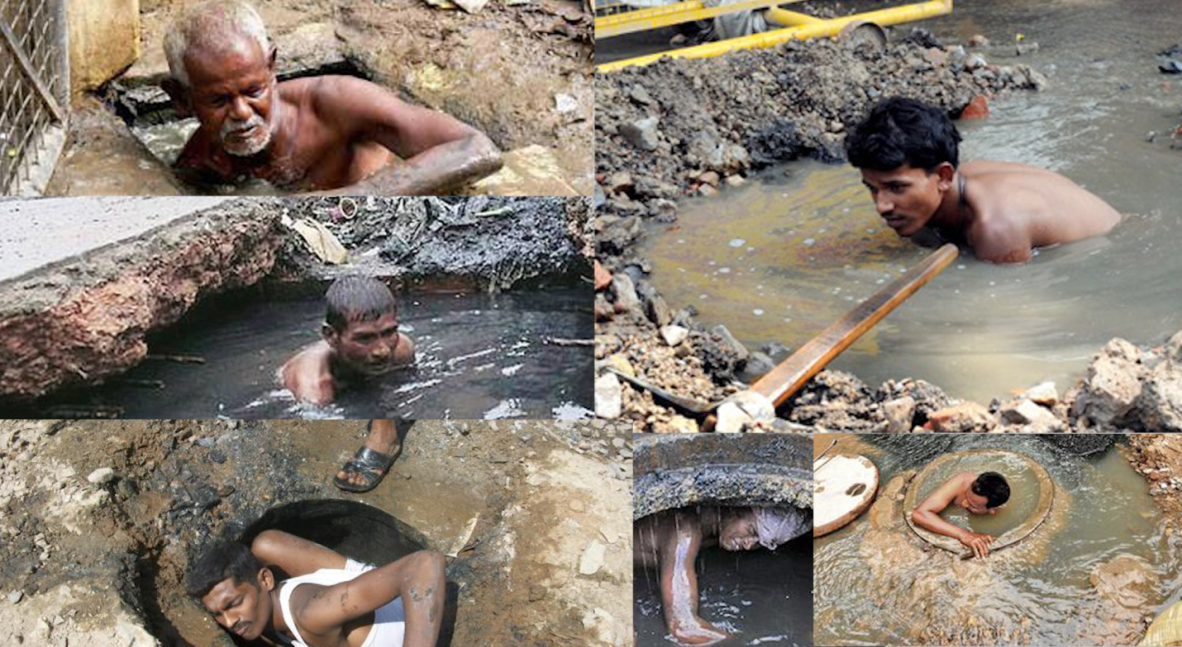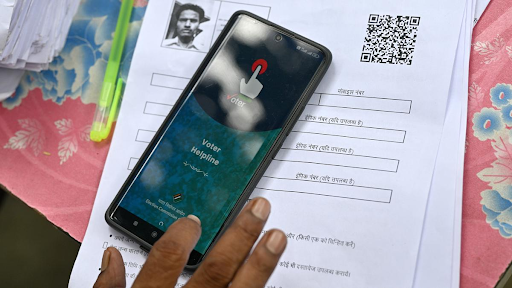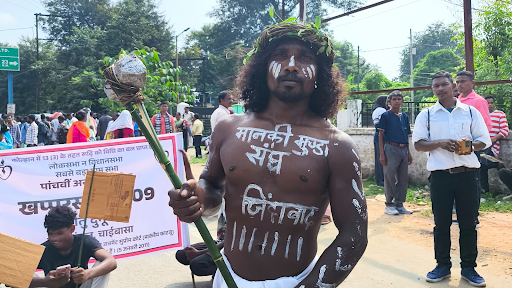Description

Copyright infringement not intended
In News
- The Union Minister of State for Housing and Urban Affairs has announced the ‘NAMASTE scheme’ for cleaning sewers and septic tanks.
- NAMASTE (National Action Plan for Mechanized Sanitation Ecosystem) Scheme is a joint venture between;
- The Department of Drinking Water and Sanitation.
- The Ministry of Social Justice and Empowerment.
- The Ministry of Housing and Urban Affairs.
- The main objective of the scheme is to ensure;
- Zero fatalities in sanitation work in India.
- No sanitation workers come in direct contact with human faecal matter.
- All Sewer and Septic tank sanitation workers have access to alternative livelihoods.
- The Ministry has announced that;
- They have shortlisted the types of machinery and core equipment required for maintenance works and Safety gear for Safai Mitras.
- Skill Development and training of Safai Mitras to be conducted with the help of the Ministry of Social Justice and Empowerment through the National Safai Karamchari Finance Development Corporation.
Sanitation workers in India
- Despite the various laws, Sanitation workers in India constantly face stigma and are devoid of fundamental rights.
- During the 1990s, various civil societies started a movement to abolish dry latrines.
- This movement has always demanded the abolition of the dehumanising practise of the manual removal of human excreta.
- In the present time, the focus shifted to manhole deaths and the requirement of safety equipment for sanitation workers.
- The Union government has enacted an Act in 1993, the act restrict the construction of unsanitary dry latrines and employing manual scavengers.
- With time, the construction of dry latrines has reduced, but the number of deaths in manholes, sewers and septic tanks continues to remain high.
- According to the data released by the Social Justice and Empowerment Ministry, a total of 971 people lost their lives while cleaning sewers or septic tanks since 1993, the year law prohibiting the employment of manual scavengers was passed.
Manual Scavenging
- Manual scavenging is a term used mostly for "manually cleaning, carrying, disposing of, or otherwise handling, human excreta in an insanitary latrine or an open drain or sewer or a septic tank or a pit".
- Manual scavengers usually use hand tools such as buckets, brooms and shovels. The workers have to move the excreta, using brooms and tin plates, into baskets, which they carry to disposal locations sometimes several kilometres away.
- The occupation of sanitation work is tied with the caste in India. All kinds of cleaning are considered lowly and are assigned to people from the so-called lowest caste of the social hierarchy.
- In the caste-based society, it is mainly the so-called lower caste or Dalits who work as sanitation workers.
- According to data by the Union Social Justice and Empowerment Ministry, the government has caste-related data of 43,797 identified manual scavengers, and over 42,500 of them belong to the Scheduled Castes, 421 to the Scheduled Tribes, and 431 to Other Backward Classes.
- The construction of dry toilets and the employment of manual scavengers to clean such dry toilets were prohibited in India in 1993.
- The law was extended and clarified to include a ban on the use of human labour for direct cleaning of sewers, ditches, pits and septic tanks in 2013.
- India banned the practice of Manual scavenging under the Prohibition of Employment as Manual Scavengers and their Rehabilitation Act, 2013 (PEMSR).
- The Act bans the use of any individual for manually cleaning, carrying, disposing of or otherwise handling in any manner, human excreta till its disposal.
- In 2013, the definition of manual scavengers was also broadened to include people employed to clean septic tanks, ditches, or railway tracks.
- The Act recognizes manual scavenging as a “dehumanizing practice,” and cites a need to “correct the historical injustice and indignity suffered by the manual scavengers.”
- Socio-Economic and Caste Census (SECC) released in 2015, states that there were around 18 million manual scavenging households in rural areas.
- Statistics show that 80% of India’s sewage cleaners die before they turn 60, after contracting various infectious diseases.
- Reasons:
- Manual scavenging persists mainly because of the continued presence of insanitary latrines.
- It is strongly connected to the caste system.
- Lack of support by society to eliminate this most inhuman profession.
- Lack of education and humanity is missing in many parts of India.
- Data show the manual scavengers' reluctance to take up self-employment, even if they try to switch their job; they face social discrimination due to their caste.
Concern
- Even though manual scavenging is banned in India, the practice is still prevalent in many parts of the country.
- Only in 30% of cases of Compensation awarded after death, hardly anyone receives the Rehabilitation or Alternative jobs to which they are entitled by law.
- Employers and local authorities are not providing Protective measures.
- When the Government builds toilets through its Swachh Bharat Abhiyan, it is not taking into account the question of who will have to clean the septic tank.
- Rehabilitation has been Slow because they are mostly illiterate and have no Skill to do any work other than Sanitation related activities.
- Most sanitation staff hardly has any ID cards, protection of medical insurance policies, etc.
- The workers in sanitation departments are recruited through open competition. The local administration usually approaches particular cast members during such hiring.
- The situation is so alarming that while we find volunteers to distribute food and undertake rescue operations during natural calamities, hardly any volunteer offers to do clean-up work or dispose of dead bodies.
- There are no vehicles for sanitation workers to travel to their designated workplace, and they have to either walk for kilometres or use garbage vehicles. This is forced choice and is connected to the dignity of a worker.
- There are hardly any exclusive trade unions for sweepers, and unlike other sections in the government or private workforce, their problems are expressed by mainly those who are not associated with sanitation work (Civil society or NGOs).
- Despite the laws, manual scavenging was reported in many states. In 2021, the National Human Rights Commission observed that the eradication of manual scavenging as claimed by state and local governments is far from over.
Steps by the Government
- Sanitation is a State subject as per the 7th Schedule.
- In 2013 Delhi announced that they were banning manual scavenging, making them the first state in India to do so.
- District magistrates are responsible for ensuring that no manual scavengers are working in their district.
- "The Employment of Manual Scavengers and Construction of Dry Latrines (Prohibition) Act, 1993", drafted by the Ministry of Urban Development was passed by Parliament in 1993.
- The act punishes the employment of scavengers or the construction of dry (non-flush) latrines with imprisonment for up to one year and/or a fine of Rs 2,000.
- In 2007 the Self Employment Scheme for Rehabilitation of Manual Scavengers was passed to help in the transition to other occupations.
- The Prohibition of Employment as Manual Scavengers and their Rehabilitation Act 2013.
- Prohibition of Employment as Manual Scavengers and their Rehabilitation (Amendment) Bill, 2020.
- The Bill calls for complete mechanization of cleaning sewers and septic tanks.
- Safaimitra Suraksha Challenge was launched by the Ministry of Housing and Urban Affairs to make sewer cleaning mechanized.
- ‘Swachhta Abhiyan App’ has been developed to identify and Geotag the data of insanitary latrines and manual scavengers so that the insanitary latrines can be replaced with sanitary latrines and rehabilitate all the manual scavengers to provide dignity of life to them.
- In 2014, the Supreme Court order made it mandatory for the government to identify all those who died in sewage work since 1993 and provide Rs. 10 lakh each as compensation to their families.
Way Forward
- India’s Supreme Court has ruled that the practice of manual scavenging violates international human rights law, including protections found in the Universal Declaration of Human Rights (UDHR), the International Convention on the Elimination of All Forms of Racial Discrimination (ICERD), and the Convention on the Elimination of All Forms of Discrimination against Women (CEDAW).
- India is also a party to other international conventions that reinforce obligations to end manual scavenging.
- Article 21 of the Constitution guarantees the Right to Life’ and that also with dignity.
- Need to ensure proper implementation of the Self Employment Scheme for Rehabilitation of Manual Scavengers, and promote Alternative opportunities or Jobs.
- Ensure that rehabilitation entitlements under the 2013 Act—including financial assistance, scholarships, housing, alternative livelihood support, and other important legal and programmatic assistance—are available to manual scavenging communities.
https://newsonair.gov.in/News?title=Govt-formulates-NAMASTE-scheme-for-cleaning-of-sewers%2c-septic-tank%3a-MoS-for-Housing-and-Urban-Affairs-in-Rajya-Sabha&id=444419
1.png)
https://t.me/+hJqMV1O0se03Njk9













